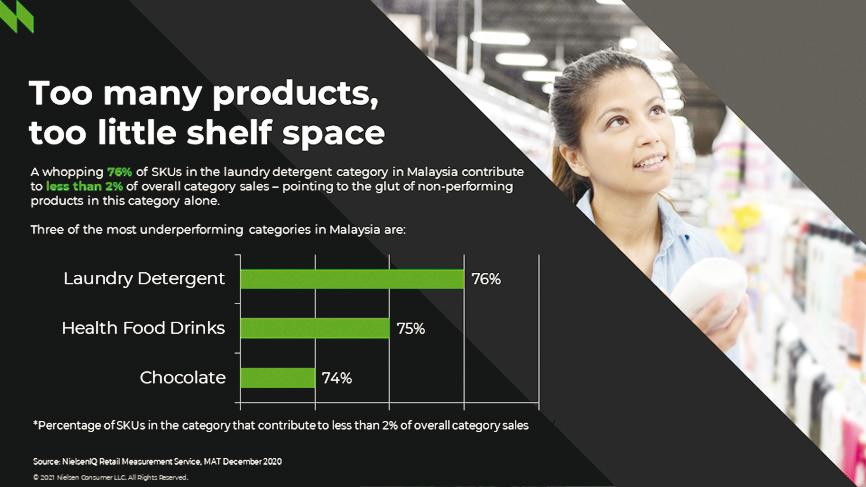PETALING JAYA: Now is the time for fast-moving consumer goods (FMCG) manufacturers to reassess and rationalise their assortment in order to better meet the changing needs of pandemic-hit consumers, and to enjoy greater savings and profitability, according to NielsenIQ.
Across the globe, there are structural challenges with assortment across most FMCG categories.
Looking at the most underperforming categories in emerging and developing markets, on average, 75% of stock-keeping units (SKUs) contribute to less than 2% of category sales. Beverage, instant noodles, chocolate, and detergent are some of the most underperforming categories in the top 15 markets.
In Malaysia, for example, a whopping 76% of SKUs in the laundry detergent category contribute to less than 2% of overall category sales – pointing to the glut in non-performing products and variants that exist within just this one category alone.
The same can be seen across other key categories such as health food drinks (75%) and chocolate (74%), showing that this is not an isolated incident, but rather one that needs to be addressed by the entire FMCG industry.
“Over the years, there has been a proliferation of brands, products and SKUs in the marketplace as manufacturers compete to satiate consumers’ appetite for new variations, products and experiences. Finding and maintaining an optimal assortment has always been a challenge. The Covid-19 pandemic as well as intensifying competition have elevated this test to a new level,” said NielsenIQ senior vice president and analytics leader, APAC & EEMEA, Didem Sekerel Erdogan.
“But for manufacturers and retailers, more is not more, but rather the opposite as manufacturers end up investing in production and in-store shelf space for products that do not drive any incremental value, thereby eating into their profit margins.”
Changes in consumer behaviour brought about by the Covid-19 pandemic also require manufacturers to reassess their assortment.
First, newly constrained, existing constrained and cautiously insulated consumers are streamlining their budgets and have become more discerning about what, where, when and how they purchase products.
Second, shoppers are increasingly favouring smaller store formats, and this only reinforces the need to make the best possible use of limited space. For the past three years, it is observed that shoppers in Malaysia have been moving away from large format stores such as hypermarkets towards smaller formats (up 5% in 2019 versus 2018) such as convenience stores and mini markets.
With the rise in e-commerce and increased trust in online shopping platforms, shoppers are visiting physical stores less often and when they do, they come prepared with lists and they spend less time browsing the shelves than they did before the pandemic.
NielsenIQ Malaysia managing director cum analytics leader of Southeast Asia Luca De Nard said financially impacted consumers have less money to spend, and will therefore be more focused on essentials.
“That doesn’t mean that they will not have the desire to indulge once in a while. The challenge for manufacturers and retailers is to ensure that the products and brands in their portfolio cater to consumers at all ends of the economic spectrum, while also remaining cost-efficient and eliminating wastage.”
The case for assortment rationalisation is extremely strong. A recent NielsenIQ study demonstrated that an average of seven items are launched daily in Malaysia, and 30% of promising innovations do not get enough support to realise their full potential. Complementary studies by Bain & Company show that a 10-20% SKU reduction can result in up to 10% of savings in production costs, up to 10% reduction in supply chain costs, up to 10% lower inventory and up to 5% optimisation in raw materials and packaging costs.
De Nard highlighted that rationalising assortment is not just about eliminating those SKUs with low sales. It requires a more sophisticated and data-driven approach, focused on the idea of incrementality, which means building a range that can drive profitable growth while drawing the interest of more shopper segments (through niche products, for example).
“By correctly identifying which SKUs to retire and keep, not only can manufacturers focus production and supply chain efforts on incremental brands and SKUs, but they can also eliminate waste, increase profitability and reinvest profits into new product development, which will ultimately capture new shoppers. This is a win for the shopper, win for the manufacturer and a win for the retailer,” De Nard said.















